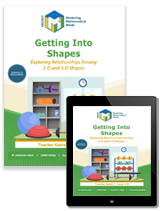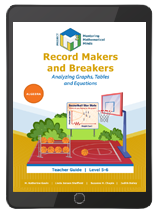Search Listing Name
product:
The World Turned Upside Down: The American Revolution Student Guide
The World Turned Upside Down: The American Revolution
Grades 4-5
Intensive document analysis and exploration of the concept of cause and effect form the foundation of this unit, which focuses on the Revolutionary period in American history. The unit explores the chronology and major event
product:
Project M3: Level 4-5: Treasures From the Attic: Exploring Fractions Student Mathematician's Journal + 1 Year License
The Student Mathematician’s Journal allows students to explore simulated or real-life problems and help them to think, write, and read like mathematicians. It encourages students to reflect on what they have learned in each lesson, think deeply about mathematics, and communicate in writing on worksheets.
Students are introduced to Tori and Jordan, who uncover hidden treasures in their gran
product:
OpenSciEd Unit 8.2: Sound Waves Teacher Edition
OpenSciEd Middle School science program addresses all middle school NGSS standards. This comprehensive science curriculum empowers students to question, design, investigate, and solve the world around them.
- Phenomenon Based - Centered around exploring phenomena or solving problems
- Driven by Student Questions - Storyline based on students’ questions and ideas
- Grounded in Evidence - Incremental building and revision of ideas based on evidence
- Collaborative - class and teacher figure
product:
Project M2 Level 2 Unit 1: Designing a Shape Gallery: Geometry with the Meerkats Student Mathematician Journal 1 Year License
The Student Mathematician’s Journal presents simulated or real-life problems that encourage students to think, write, and read like mathematicians. They are asked to reflect on what they have learned and communicate in writing on worksheets.
In this unit, students explore two- and three-dimensional shapes and the relationships among them. The reasoning and spatial-sense skills they use will help the

product:
Project M3: Level 4-5: Getting Into Shapes: Exploring Relationships Among 2-D and 3-D Shapes Teacher Guide + 3 Year License
In this unit, students explore two- and three-dimensional shapes with a focus on their properties, relationships among them and spatial visualization. The reasoning skills that they build upon in this unit help them to develop an understanding of more complex geometric concepts.
The Teacher Guide is designed to provide background information on the mathematics being taught in this unit, the learning environment, mathematical communication, and differentiated instruction. Also included:
product:
COVID-19 Health Equity High School: What can we learn form the spread of the COVID-19 virus to protect our communities? Teacher Edition
This unit is designed to support students in understanding the COVID-19 pandemic, transmission of the COVID-19 virus, and the impacts of the pandemic on communities, especially communities of color. Specific learning targets are listed at the beginning of each lesson and highlight a core idea for the lesson, the science and engineering practice students will engage in, and the crosscutting concept students will use in the lesson. There are four broad areas of learning goals targeted in this unit:<

product:
Project M3: Level 5-6: Record Makers and Breakers: Analyzing Graphs, Tables and Equations Teacher 3 Year License
In this unit, students explore algebra as a system of concepts used to represent relationships. They learn to express these relationships using words, equations, tables, and graphs. By exploring world records, some of the most astonishing feats ever achieved, they see algebra in action and even start imagining their own record-breaking possibilities. They also learn about algebra as a style of mathematical thinking for formalizing patterns of change. They extend their notion of variable from a letter in an equation that represents a number to a broader definition, that of a qu
